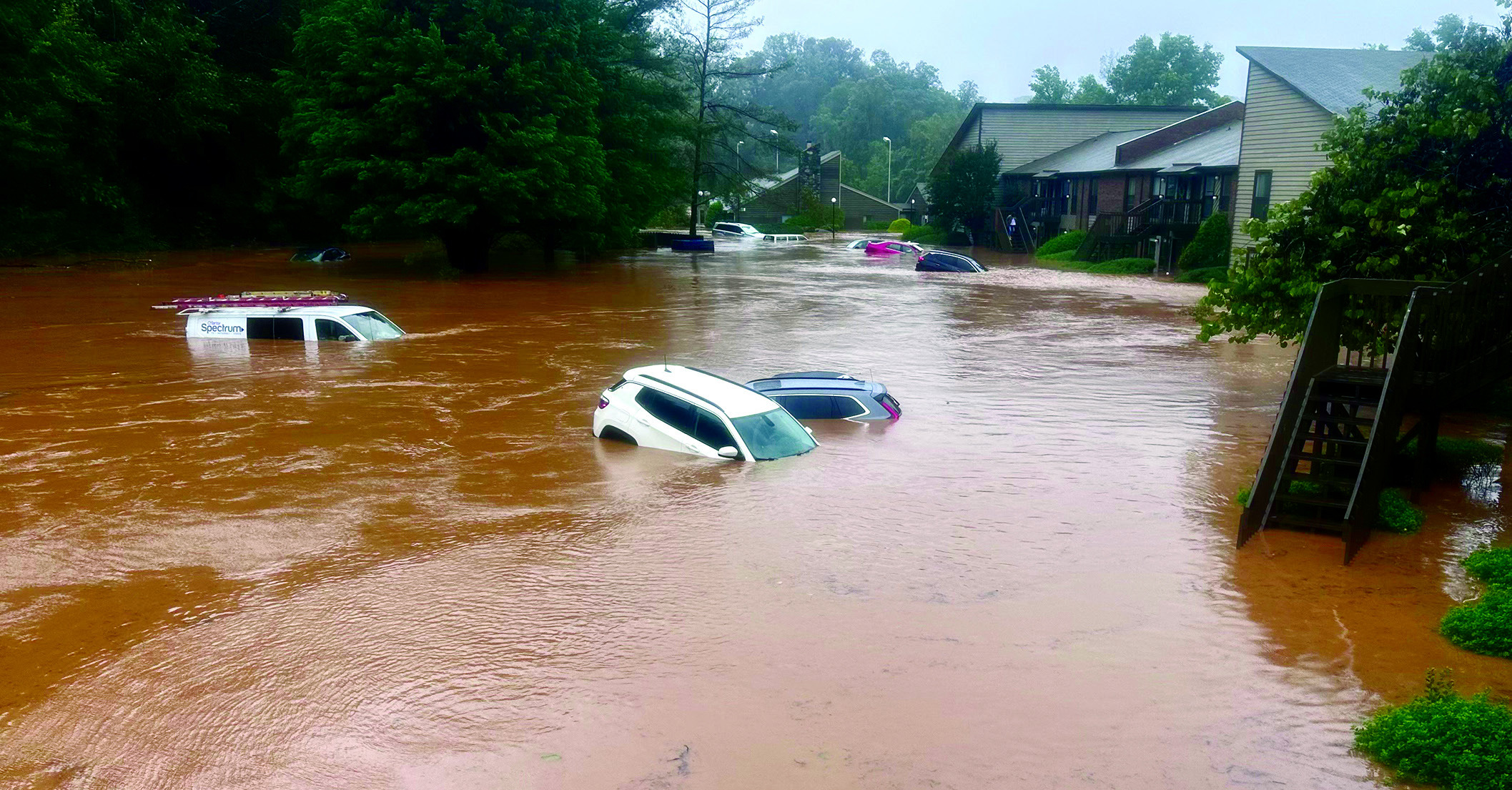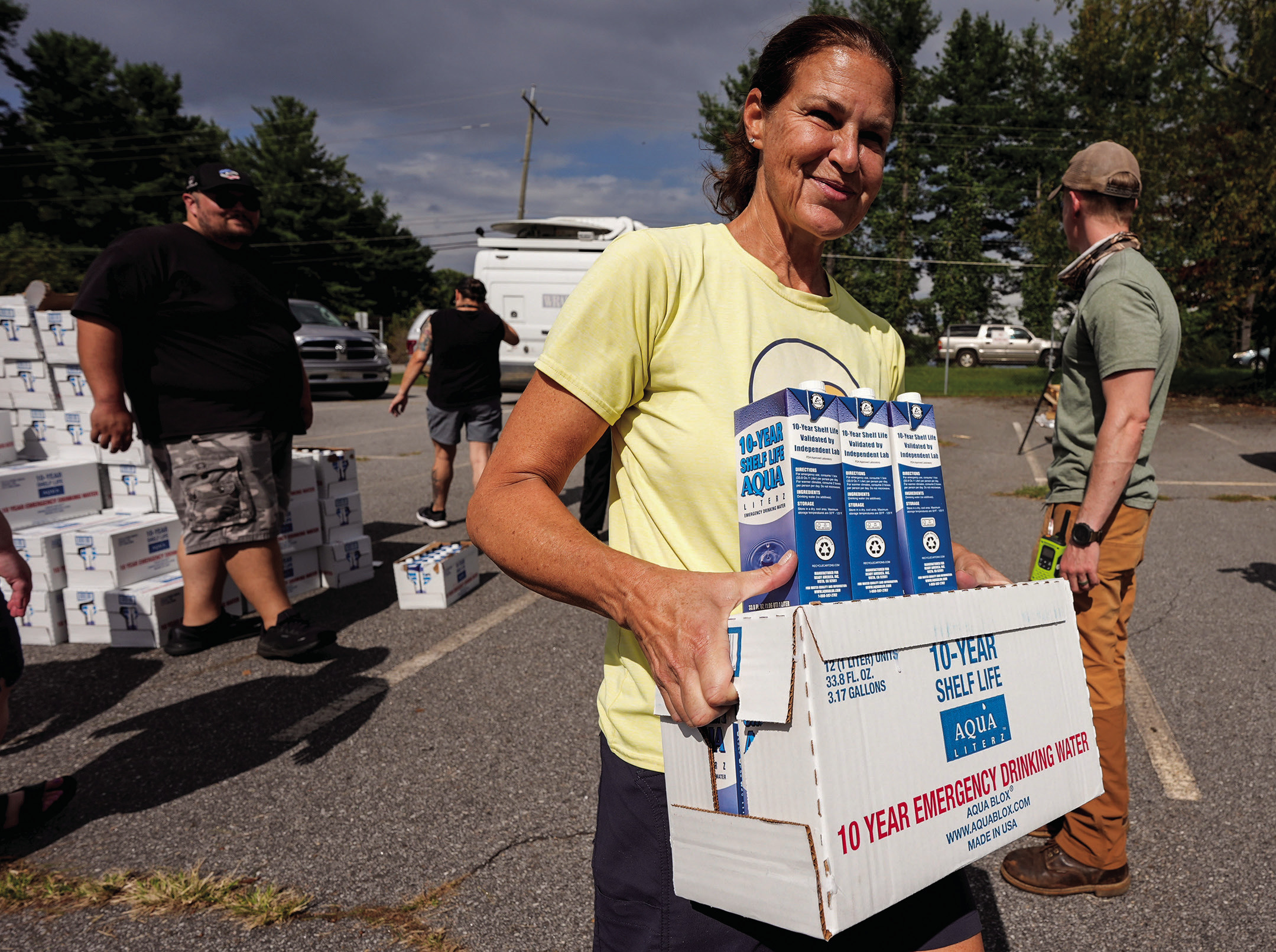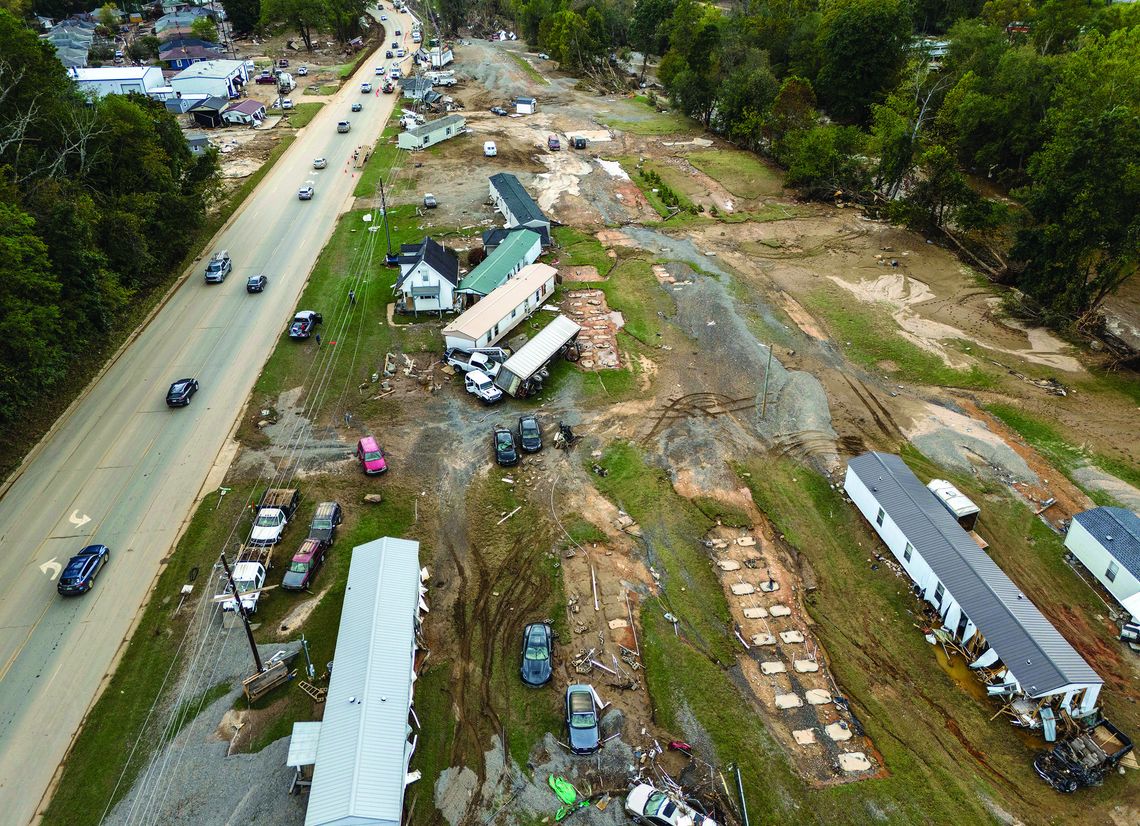Blaine Noss, formerly of Chanute and Neodesha, credits his cat, Turtle, for keeping him from harm as heavy rain caused the Swannanoa River to flood his apartment in Asheville, North Carolina, late last month.
Noss, a 2014 graduate of Neodesha High School, is now rebuilding his life in North Carolina after Hurricane Helene flooding destroyed his car and possessions. He was able to get out of his apartment only with the clothes on his back, a T-shirt and boxers, and his cat. He left without his shoes.
He visited with the Tribune on Saturday while traveling back to Flat Rock, North Carolina, where he moved after the flooding. He had come to Southeast Kansas to visit family in Neodesha last week.
The Sept. 27 storm caused billions in damage in North Carolina and in other states, according to media reports, as rain swelled creeks and rivers, flooding homes and destroying or damaging roads and bridges. The Washington Post reported Sunday that the storm killed at least 98 people in 22 counties of North Carolina. Earlier estimates tallied more than 200 deaths across multiple states in the path of the storm.
Noss, 28, said the view from his apartment along the Swannanoa River before the hurricane was picturesque, beautiful. He has lived in North Carolina since 2021 and he works for Charter Spectrum, which provides internet coverage and other connectivity options for customers, including mobile phones. He enjoys hiking on trails and in the Appalachian Mountains.
He said his company was preparing for the hurricane, but expectations were it would be like any other hurricane, bringing rain, wind and knocking down trees.
“No one over there expected it to get as bad as it did,” said Noss.
In the aftermath, the governor of North Carolina called Helene the worst storm to hit the state. It’s been called a 500year storm, meaning a storm that one could expect to see every 500 years.
Noss made preparations. Many times when there is a storm and the river water rises, the water system in Asheville goes down, he said. He filled his tub with water and made sure his flashlights had fresh batteries. This was basic storm prep and this was not his first hurricane since he moved to the East Coast.
No one called for evacuations in his area but he knew as the storm approached that it could get bad. Flooding was predicted, something he was familiar with having lived in Neodesha during the flood of 2007.
“I figured it was gonna suck. It was gonna get bad. I was gonna be without power for maybe a week. But none of the messages that came through warned about catastrophic flooding,” Noss said.
He said his apartment was built up from the Swannanoa River, a river that he said was smaller than the Neosho. The Swannanoa feeds into the French Broad, a larger river in Asheville.
He had worked Thursday and was going to get back to work on Friday afternoon. He woke up on Friday, Sept. 27, about 8 a.m. The power was out. He drifted off to sleep again.
“Soon after that, in my bed, my cat just starts running around frantically, jumps on me and she’s sopping wet. Sopping and started meowing at me, woke me up, and that’s when I kind of looked around,” Noss said.
At first, he thought the water was from a washing machine overflowing in a nearby apartment. He got out of bed and realized the water was up past his shin in his first-floor apartment.
His phone showed 9 a.m. and he looked at the window facing the Swannanoa and water was gushing through the window.
“My cat woke me up before it got real bad essentially, but I opened my front door and that’s when it was a game changer. Because the water outside was way higher than it was inside my apartment, probably up to my waist,” Noss said.
He placed Turtle in a carrier. He said he had to force his door open after releasing water pressure by breaking his apartment window. He knew the situation was serious at this point.
The water level was higher outside and he heard someone calling for help. A neighbor, an older woman, had a friend visiting and they could not get out of their apartment. He put his cat on higher ground and was able to free his neighbor and her friend the same way he got out of his apartment, by breaking a window to level out the water pressure.
See HELENE, Page 10.

He helped the women up the stairs to higher ground when his neighbor told him about her cat still in the apartment. So he went back downstairs and rescued the cat, he said.
Water was rising fast and it was up to his chest now on the lower floor.
Firefighters showed up shortly after this and performed rescues and took Noss and his neighbor and her friend to safety, along with the cats and a pet guinea pig. The water was up to the second story of the apartment complex by then.
“The water current was just so, so crazy, gushing around. I was scared the apartment was going to collapse, it was flowing that hard,” Noss said.
He then called his mother to let her know what was going on but the cell service dropped at that time and no calls could go in or out.
“That’s when it got really freaky, the closest post-apocalyptic thing ever, not having communications at all.”
City officials directed the displaced to the Cherokee Center, a big arena in Asheville. There weren’t enough beds or blankets, Noss said.
He said he’d heard since then about evacuations in some towns, including a town near a dam that was holding back the rising water. He said that community was decimated by flooding and other communities downriver were impacted when flood gates were opened to release water.
He stayed with his neighbor and her friend as long as he could because she needed help getting around. Asheville and its businesses and people started working to help those displaced and impacted by the flood, offering bottled water, food and shelter.
Eventually, they found phone service and his neighbor’s friend contacted her husband in West Virginia. He drove to them after bypassing road and bridge outages. They drove to find cell service, which they eventually found in Gastonia near Charlotte. Noss was going to fly back to Kansas to regroup but realized he didn’t have any ID.
Noss called a friend who picked him up in Gastonia and drove him to Hendersonville, which wasn’t hit as hard as Asheville. He stayed with them. Power was still out and there still was no running water.
He had no work vehicle and needed to get back to work to help rebuild the damaged infrastructure. His work van was underwater at his apartment. His clothes and possessions were underwater as well as his car.
Noss said his company got him clothes so he could get to work on damage assessment.
“This was beyond chaotic. Beyond the most destruction I’ve ever seen,” he said. “It was pretty bad. The worst thing I will probably ever see.”
Power and water service eventually returned and the Federal Emergency Management Agency showed up.
But people had been helping each other people before then, neighbor helping neighbor.
“The one thing that kind of kicked off everything was just how everybody helped each other,” he said, as the displaced found comfort in and help from others.
“There was a lot of goodness that happened. Just a lot of people helped,” Noss said.
He returned to his apartment complex but wasn’t allowed in because of the damage. He found his wallet and ID in his work truck.
Noss said he’d been working long hours since the flood. He was able to get a new car through insurance and got a new apartment at a higher elevation with no river nearby in Flat Rock, North Carolina. Family and friends have helped him rebuild his life.
“I’m never living close to a river again,” he said.
He said Asheville looked like a war zone. Other communities were destroyed. Recovery will take time.
“It’s going to be a long time before anything happens there,” he said.
He said in the aftermath of the hurricane, businesses, churches and individuals stepped up and offered free food, water other items to those in need. The military helped with supplies as well.
Duke Energy started working to overhaul the electrical system to get it back online. Noss said he saw Evergy trucks there and Canadians.
DAN
Evergy sent 120 internal line workers and about 250 additional contractors who work primarily with Evergy to assist in Kentucky, Virginia, Ohio, North Carolina and Florida, according to Evergy spokesperson Courtney Lewis in Topeka. About 50,000 line workers from 40 states plus Canada responded to the region, she said.
Evergy crews returned home on Oct. 7.
Noss said the outside help, through utilities and those offering other necessities, got everybody back on their feet sooner than expected. He said people flew in supplies by private helicopter. Military helicopters brought necessities.
“That’s what really made the difference was everybody helping each other out,” Noss said. His company was equally generous.
“Everyone kept their cool and everyone helped each other out.”
He said he filed his claim with FEMA as soon as he could.
Noss said he hopes to never see another 500-year event again.
“I don’t want to see another one. I’ll come back home if it happens again.”








